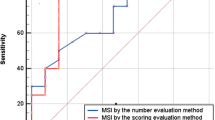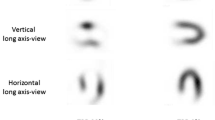Abstract
Purpose
We hypothesized that, because of persistent stunning, the extent of post-treatment functional abnormalities detected using gated single-photon emission computed tomography (SPECT) could be representative of the initial risk area in acute myocardial infarction (AMI) treated by reperfusion therapy.
Materials and methods
In 48 AMI patients, we acquired two 99mTc-sestamibi gated SPECT studies (at admission with tracer injection before treatment and at discharge 5 to 10 days later). We assessed the myocardial salvage defined by the admission minus predischarge summed rest score, and we compared it with the value obtained by subtracting the extent of perfusion defect from the extent of wall motion or wall thickening abnormalities in predischarge gated SPECT. Myocardial salvage was expressed as salvage index (salvaged myocardium divided by initial risk area).
Results
There was a good correlation between summed rest score salvage index and wall motion (Spearman’s ρ = 0.754, p < 0.0001) or wall thickening salvage index (Spearman’s ρ = 0.798, p < 0.0001). The wall thickening salvage index was able to classify correctly the patients that had a summed rest score salvage index ≥ 0.10 with 73% sensitivity, 88% specificity, and 83% accuracy. The wall motion salvage index was highly sensitive (91%) but poorly specific (13%, p < 0.002 vs wall thickening salvage index) and less accurate (69%, p < 0.05 vs wall thickening salvage index).
Conclusions
99mTc-sestamibi gated SPECT allows assessing myocardial salvage using only post-treatment data. The salvage index derived using wall thickening as surrogate of admission perfusion defect correlates well with the salvage index measured by comparing pre- and post-treatment perfusion defects.

Similar content being viewed by others
References
Gruppo Italiano per lo Studio della Streptochinasi nell’ Infarto Miocardico (GISSI). Effectiveness of intravenous thrombolytic treatment in acute myocardial infarction. Lancet 1986;1:397-402.
Keeley EC, Boura JA, Grines CL. Primary angioplasty versus intravenous thrombolytic therapy for acute myocardial infarction: a quantitative review of 23 randomised trials. Lancet 2003;361:13-20.
Stone GW, Cox D, Garcia E, Morice MC, Griffin J, Mattos L, et al. Normal flow (TIMI-3) before mechanical reperfusion therapy is an independent determinant of survival in acute myocardial infarction: analysis from the primary angioplasty in myocardial infarction trials. Circulation 2001;104:636-41.
Schöming A, Ndrepepa G, Kastrati A. Late myocardial salvage: time to recognize its reality in reperfusion therapy of acute myocardial infarction. Eur Heart J 2006;27:1900-7.
Christian TF, Schwartz RS, Gibbons RJ. Determinants of infarct size in reperfusion therapy for acute myocardial infarction. Circulation 1992;86:81-90.
Simoons ML, Serruys PW, van den Brand M, de Zwaan C, Res J, Verheugt FW, et al. Improved survival after early thrombolysis in acute myocardial infarction. A randomised trial by the Interuniversity Cardiology Institute in the Netherlands. Lancet 1985;2:578-82.
The GUSTO Angiographic Investigators. The effects of tissue plasminogen activator, streptokinase, or both on coronary-artery patency, ventricular function, and survival after acute myocardial infarction. N Engl J Med 1993;329:1615-22. (Erratum in N Engl J Med 1994;330:516).
Gibbons MK, Mahmarian JJ, Chesebro JH, Wackers FJ. Feasibility of tomographic 99mTc-hexakis-2-methoxy-2-methylpropyl-isonitrile imaging for the assessment of myocardial area at risk and the effect of treatment in acute myocardial infarction. Circulation 1989;80:1277-85.
Santoro GM, Bisi G, Sciagrà R, Leoncini M, Fazzini PF, Meldolesi U. Single photon emission tomography with technetium-99 m hexakis 2-methoxyisobutyl isonitrile in acute myocardial infarction before and after thrombolytic treatment: assessment of salvaged myocardium and prediction of late functional recovery. J Am Coll Cardiol 1990;150:301-14.
Gibbons RJ, Holmes DR, Reeder GS, Bailey KR, Hopfenspinger MR, Gersh BJ. Immediate angioplasty compared with the administration of thrombolytic agent followed by conservative treatment for myocardial infarction. The Mayo Coronary Care Unit and Catheterization Laboratory Groups. N Engl J Med 1993;328:685-91.
Kastrati A, Mehilli J, Dirschinger J, Schricke U, Neverve J, Pache J, et al. Stent versus Thrombolysis for Occluded Coronary Arteries in Patients With Acute Myocardial Infarction (STOPAMI-2) Study. Myocardial salvage after coronary stenting plus abciximab versus fibrinolysis plus abciximab in patients with acute myocardial infarction: a randomised trial. Lancet 2002;359:920-5.
Santoro GM, Antoniucci D, Valenti R, Bolognese L, Buonamici P, Trapani M, et al. Rapid reduction of ST-segment elevation after successful direct angioplasty in acute myocardial infarction. Am J Cardiol 1997;80:685-9.
van’t Hof AW, Liem A, Suryapranata H, Hoorntje JC, de Boer MJ, Zijlstra F. Angiographic assessment of myocardial reperfusion in patients treated with primary angioplasty for acute myocardial infarction: myocardial blush grade. Zwolle Myocardial Infarction Study Group. Circulation 1998;97:2302-6.
Gibbons RJ, Miller TD, Christian TF. Infarct size measured by single photon emission computed tomographic imaging with (99m)Tc-sestamibi: a measure of the efficacy of therapy in acute myocardial infarction. Circulation 2000;101:101-8.
Klocke FJ, Baird MG, Lorell BH, Bateman TM, Messer JV, Berman DS, et al. ACC/AHA/ASNC guidelines for the clinical use of cardiac radionuclide imaging—executive summary: a report of the American College of Cardiology/American Heart Association Task Force on Practice Guidelines (ACC/AHA/ASNC Committee to Revise the 1995 Guidelines for the Clinical Use of Cardiac Radionuclide Imaging). Circulation 2003;108:1404-8.
Braunwald E, Kloner RA. The stunned myocardium: prolonged, postischemic ventricular dysfunction. Circulation 1982;66:1146-9.
Spinelli L, Petretta M, Cuocolo A, Nicolai E, Acampa W, Vicario L, et al. Prediction of recovery of left ventricular dysfunction after acute myocardial infarction: comparison between 99mTc-sestamibi cardiac tomography and low-dose dobutamine echocardiography. J Nucl Med 1999;40:1683-92.
Sciagrà R, Leoncini M. Gated single-photon emission computed tomography. The present-day “one-stop-shop” for cardiac imaging. Q J Nucl Med Mol Imaging 2005;49:19-29.
Schömig A, Mehilli J, Antoniucci D, Ndrepepa G, Markwardt C, Di Pede F, et al. Beyond 12 hours Reperfusion Alternative Evaluation (BRAVE-2) Trial Investigators. Mechanical reperfusion in patients with acute myocardial infarction presenting more than 12 hours from symptom onset: a randomized controlled trial. JAMA 2005;293:2865-72.
Sharir T, Germano G, Waechter PB, Kavanagh PB, Areeda JS, Gerlach J, et al. A new algorithm for the quantitation of myocardial perfusion SPECT. II: validation and diagnostic yield. J Nucl Med 2000;41:720-7.
Germano G, Erel J, Lewin H, Kavanagh PB, Berman DS. Automatic quantitation of regional myocardial wall motion and thickening from gated technetium—99m sestamibi myocardial perfusion single-photon emission computed tomography. J Am Coll Cardiol 1997;30:1360-7.
Milavetz JJ, Giebel DW, Christian TF, Schwartz RS, Holmes DR, Gibbons RJ. Time to therapy and salvage in myocardial infarction. J Am Coll Cardiol 1998;31:1246-51.
Candell-Riera J, Pereztol-Valdes O, Aguade-Bruix S, Castell-Conesa J, Oiler-Martinez G, Simo M, et al. Regional wall motion and wall thickening visual scores from gated SPECT in anterior and infero-lateral myocardial infarctions. Nucl Med Commun 2004;25:201-6.
Pennell D. Myocardial salvage: retrospection, resolution, and radio waves. Circulation 2006;113:1821-3.
Ndrepepa G, Mehilli J, Schwaiger M, Schuhlen H, Nekolla S, Martinoff S, et al. Prognostic value of myocardial salvage achieved by reperfusion therapy in patients with acute myocardial infarction. J Nucl Med 2004;45:725-9.
Mochizuki T, Murase K, Higashino H, Miyagawa M, Sugawara Y, Kikuchi T, et al. Ischemic “memory image” in acute myocardial infarction of 123I-BMIPP after reperfusion therapy: a comparison with 99mTc-pyrophosphate and 201Tl dual-isotope SPECT. Ann Nucl Med 2002;16:563-8.
Di Carli MF, Prcevski P, Singh TP, Janisse J, Ager J, Muzik O, et al. Myocardial blood flow, function, and metabolism in repetitive stunning. J Nucl Med 2000;41:1227-34.
Main ML, Magalski A, Chee NK, Coen MM, Skolnick DG, Good TH. Full-motion pulse inversion power Doppler contrast echocardiography differentiates stunning from necrosis and predicts recovery of left ventricular function after acute myocardial infarction. J Am Coll Cardiol 2001;38:1390-4.
Aletras AH, Tilak GS, Natanzon A, Hsu LY, Gonzalez FM, Hoyt RF, et al. Retrospective determination of the area at risk for reperfused acute myocardial infarction with T2-weighted cardiac magnetic resonance imaging: histopathological and displacement encoding with stimulated echoes (DENSE) functional validations. Circulation 2006;113:1865-70.
Author information
Authors and Affiliations
Corresponding author
Rights and permissions
About this article
Cite this article
Sotgia, B., Sciagrà, R., Parodi, G. et al. Estimate of myocardial salvage in late presentation acute myocardial infarction by comparing functional and perfusion abnormalities in predischarge gated SPECT. Eur J Nucl Med Mol Imaging 35, 906–911 (2008). https://doi.org/10.1007/s00259-007-0663-3
Received:
Accepted:
Published:
Issue Date:
DOI: https://doi.org/10.1007/s00259-007-0663-3




